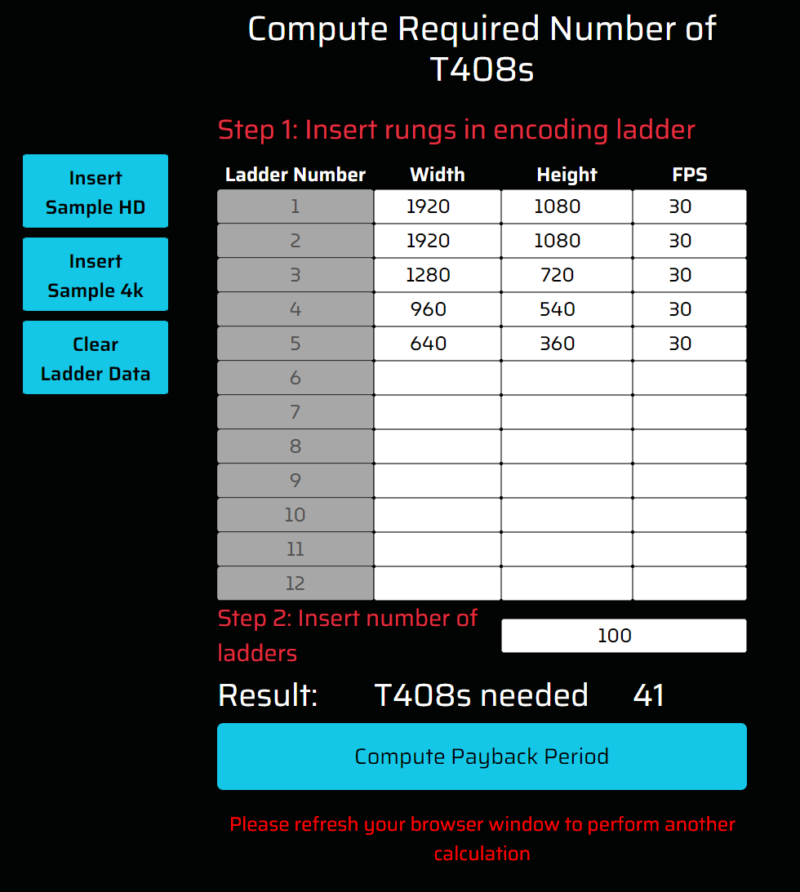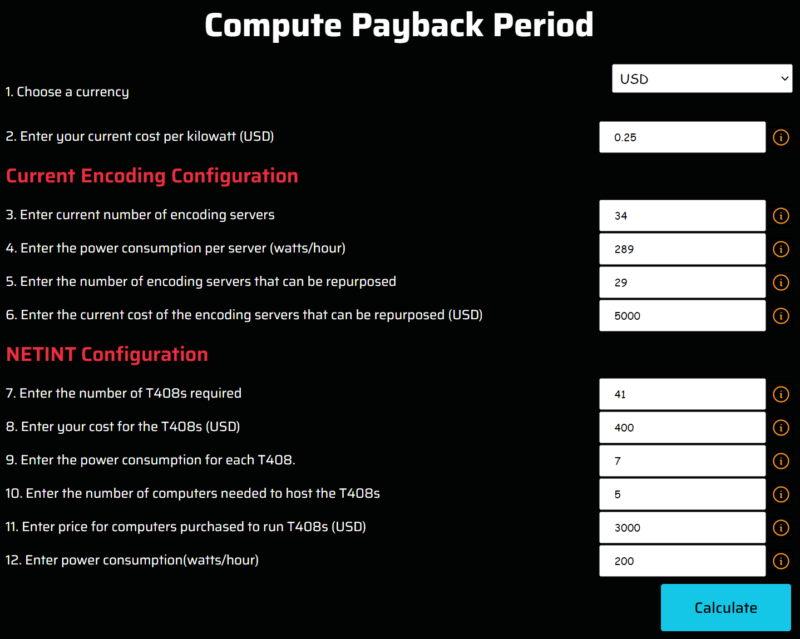One of the most power-hungry processes performed in data centers is software-based live transcoding, which can be performed much more efficiently with ASIC-based transcoders. With power costs soaring and carbon emissions an ever-increasing concern, data centers that perform high-volume live transcoding should strongly consider switching to ASIC-based transcoders like the NETINT T408.
To assist in this transition, NETINT recently published two online calculators that measure the cost savings and payback period for replacing software-based transcoders with T408s. This article describes how to use these calculators and shows that data centers can recover their investment in T408 transcoders in just a few months, even less if you can repurpose servers previously used for encoding for other uses. Most of the data shown are from a white paper that you can access here.
Contents
About the T408
Briefly, NETINT designs, develops, and sells ASIC-powered transcoders like the T408, which is a video transcoder in a U.2 form factor containing a single ASIC. Operating in x86 and ARM-based servers, T408 transcoders output H.264 or HEVC at up to 4Kp60 or 4x 1080p60 streams per T408 module and draw only 7 watts.
Simply stated, a single T408 can produce roughly the same output as a 32-core workstation encoding in software but drawing anywhere from 250 – 500 watts of power. You can install up to 24 T408s in a single workstation, which essentially replaces 20 – 24 standalone encoding workstations, slashing power costs and the associated carbon emissions.
In a nutshell, these savings are why large video publishers like YouTube and Meta are switching to ASICs. By deploying NETINT’s T408s, you can achieve the same benefits without the associated R&D and manufacturing costs. The new calculators will help you quantify the savings.
Determining the Required Number of T408s
The first calculator, available here, computes the number of T408s required for your production. There are two steps; first, enter the rungs of your encoding ladder into the table as shown. If you don’t know the details of your ladder, you can click the Insert Sample HD or 4K Ladder buttons to insert sample ladders.
After entering your ladder information, insert the number of encoding ladders that you need to produce simultaneously, which in the table is 100. Then press the Compute button (not shown in the Figure but obvious on the calculator).

This yields a total of 41 T408s. For perspective, the calculator should be very accurate for streams that don’t require scaling, like 1080p inputs output to 1080p. However, while the T408 decodes and transcodes in hardware, it relies on the host CPU for scaling. If you’re processing full encoding ladders, as we are in this example, throughput will be impacted by the power of the host CPU.
As designed, the calculator assumes that your T408 server is driven by a 32-core host CPU. On an 8-16 core system, expect perhaps 5 – 10% lower throughput. On a 64-core system, throughput could increase by 15 – 20%. Accordingly, please consider the output from this calculator as a good rough estimate accurate to about plus or minus 20%.
To compute the payback period, click the Compute Payback Period shown in Figure 1. To restart the calculation, refresh your browser.
Computing the Payback Period
Computing the payback period requires significantly more information, which is summarized in the following graphic.

- Choose your currency in the drop-down list.
- Enter your current cost per KW. The $0.25/KW is the approximate UK cost as of March 2022 from this source, which you can also access by clicking the information button to the right of this field. This information button also contains a link to US power costs here.
- Enter the number of encoders currently transcoding your live streams. In the referenced white paper, 34 was the number of required servers needed to produce 100 H.264 encoding ladders.
- Enter the power consumption per encoding server. The 289 watts shown were the actual power consumption measured for the referenced white paper. If you don’t know your power consumption, click the Info button for some suggested values.
- Enter the number of encoding servers that can be repurposed. The T408s will dramatically improve encoding density; for example, in the white paper, it took 34 servers transcoding with software to produce the same streams as five servers with ten T408s each. Since you won’t need as many encoding servers, you can shift them to other applications, which has an immediate economic benefit. If you won’t be able to repurpose any existing servers for some reason, enter 0 here.
- Enter the current cost of the encoding servers that can be repurposed. This number will be used to compute the economic benefit of repurposing servers for other functions rather than buying new servers for those functions. You should use the current replacement cost for these servers rather than the original price.
- Enter the number of T408s required. If you start with the first calculator, this number will be auto-filled.
- Enter your cost for the T408s. $400 is the retail price of the T408 in low quantities. To request pricing for higher volumes, please check with a NETINT sales representative. You can arrange a meeting at bit.ly/NETINT_meet
- Enter the power consumption for each T408. The T408 draws 7 watts of power which should be auto-filled.
- Enter the number of computers needed to host the T408s. You can deploy up to ten T408s in a 1RU server and up to 24 T408s in a 2RU server. We assumed that you would deploy using the first option (10 T408s in a single 1RU) and auto-filled this entry with that calculation. If the actual number is different, enter the number of computers you anticipate buying for the T408s.
- Enter the price for computers purchased to run T408s (USD). If you need to purchase new computers to house the T408, enter the cost here. Note that since the T408 decodes incoming H.264 and HEVC streams and transcodes on-board to those formats, most use cases work fine on workstations with 8-16 cores, though you’ll need a U.2 expansion chassis to house the T408s. Check this link for more information about choosing a server to house the T408s. We assumed $3,000 because that was the cost for the server used in the white paper.
If you’re repurposing existing hardware, enter the current cost, similar to number 6.
- Enter power consumption for the servers (watts/hour). As mentioned, you won’t need a very powerful computer to run the T408s, and CPU utilization and power consumption should be modest because the T408s are doing most of the work. This number is the base power consumption of the computer itself; the power utilized by the T408s will be added separately.
When you’ve entered all the data, press the Calculate button.
Interpreting the Results
The calculator computes the payback period under three assumptions:
- Simple: Payback Period on T408 Purchases
- Simple: Payback Period on T408 + New Computers
- Comprehensive: Consider all costs

This result divides the cost of the T408 purchases by the monthly savings and shows a payback period of around 11 months. That said, if five servers with T408s essentially replaced 34 servers, unless you’re discarding the 29 servers, the third result is probably a more accurate reflection of the actual economic impact.

This result includes the cost of the servers necessary to run the T408s, which extends the payback period to about 20.5 months. Again, however, if you’re able to allocate existing encoding servers into other roles, the third calculation is a more accurate reflection.

This result incorporates all economic factors. In this case, the value of the repurposed computers ($145,000) exceeds the costs of the T408s and the computers necessary to house them ($103,600), so you’re ahead the day you make the switch.
However you run the numbers, data centers driving high-volume live transcoding operations will find that ASIC-based transcoders will pay for themselves in a matter of months. If power costs keep rising, the payback period will obviously shrink even further.
 Streaming Learning Center Where Streaming Professionals Learn to Excel
Streaming Learning Center Where Streaming Professionals Learn to Excel









